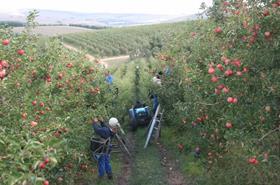
The South African apple and pear export season will continue for another six weeks, but it is certain that the industry will conclude with a record export volume.
The latest forecast indicates a 20 per cent increase to 44m cartons for apples, compared with last year’s 36.7m cartons.
The pear crop is estimated to finally reach 18m cartons, some 7 per cent up on the 2020 export volume.
Volume-wise it would indicate a very special, smooth season. However, this is perhaps not the case because there were many challenges, including logistics problems and the difficulty of finding enough containers.
“It was a good season in terms of volume,” says Hein Keulder of Fruitways. “It was also difficult in terms of managing the crop out of the country and to preferred markets.”
It is significant that the two largest regions, the Elgin-Vyeboom region and Ceres, have so far delivered 27 per cent and 30 per cent more fruit than in the previous season.
There was a particularly large jump of 64 per cent in the deliveries of Cripps Red/Yoya, while the Golden Delicious crop in Elgin-Vyeboom increased by 21 per cent.
In terms of pears the Packham’s Triumph volume increased by 20 per cent, but Forelle had a disappointing year – 20 per cent down on last year.
An analysis in marketing supply indicates that the Far East and Asia remained the largest marketing region for South African apples after a 15 per cent rise in volumes, from 8.4m cartons to 9.6m cartons.
Apple supplies to the Middle East also did particularly well with an increase of 21 per cent, Europe 25 per cent and the US and Canada by 33 per cent. Exports to Russia declined by 30 per cent.
Europe remained the largest pear market, but only slightly ahead of the Far East and Asia which showed a 20 per cent rise this year.
The UK, which has declined in recent years, received 36 per cent more South African pears this year.
It has for some years now been clear that South African apples and pears are slowly transferring out of the traditional markets of Europe and the UK to Africa, the Middle East and Asia.
This trend seems to be continuing and the latest successes in sales in India and China, led by more friendly access protocols, will advance this in future.



